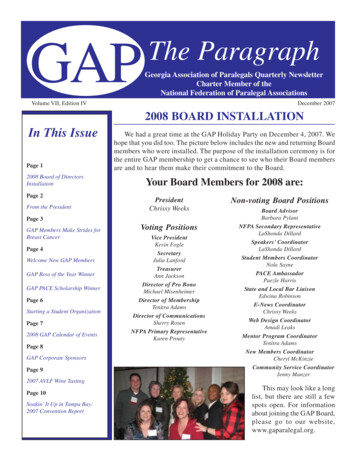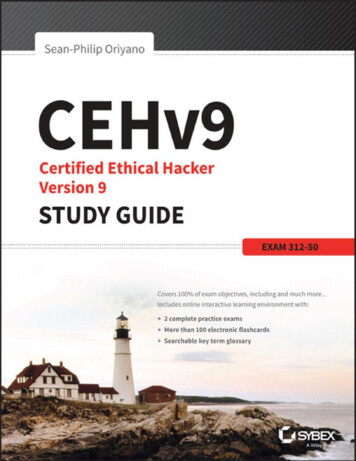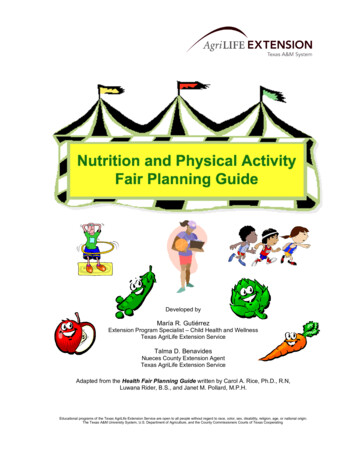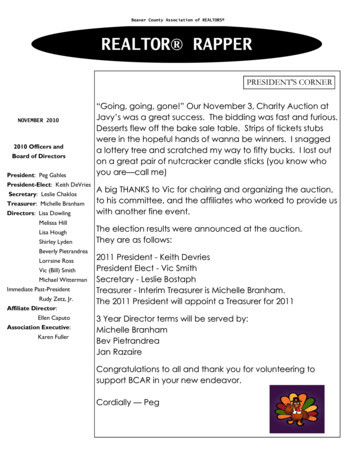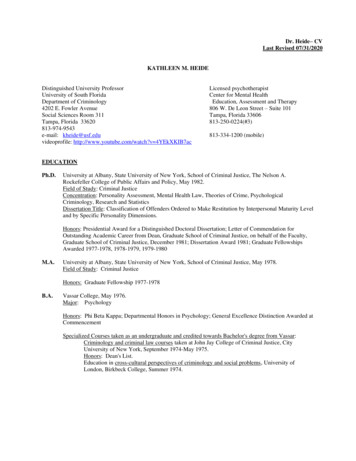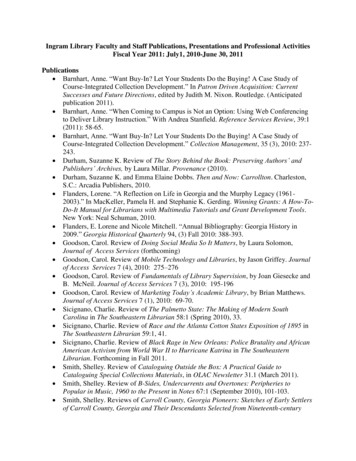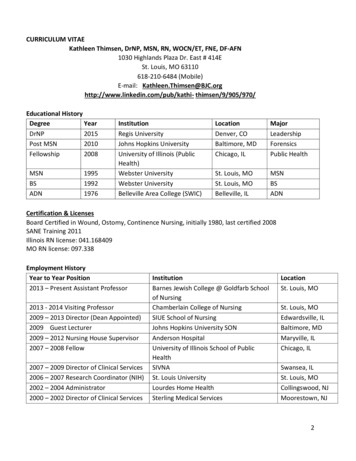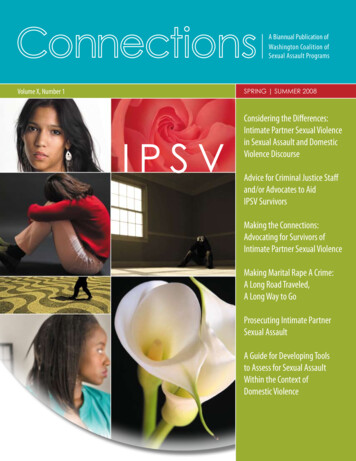
Transcription
A Biannual Publication ofWashington Coalition ofSexual Assault ProgramsVolume X, Number 1SPRING SUMMER 2008IPSVConsidering the Differences:Intimate Partner Sexual Violencein Sexual Assault and DomesticViolence DiscourseAdvice for Criminal Justice Staffand/or Advocates to AidIPSV SurvivorsMaking the Connections:Advocating for Survivors ofIntimate Partner Sexual ViolenceMaking Marital Rape A Crime:A Long Road Traveled,A Long Way to GoProsecuting Intimate PartnerSexual AssaultA Guide for Developing Toolsto Assess for Sexual AssaultWithin the Context ofDomestic Violence
Letter from the Guest Editor:TKATHLEEN ARLEDGEProgram Management SpecialistWCSAPKathleen Arledge is the programmanagement specialist forWashington Coalition of SexualAssault Programs. Kathleen hasthe honor of providing management and organizational development services to over 40 rapecrisis centers in WashingtonState. Additionally, she providesstatewide technical assistance inthe areas of sexual assault andstalking within the context ofdomestic violence. Ms. Arledgeholds a master’s degree in socialwork administration from theUniversity of Washington.wo years ago, the Washington Coalition of Sexual Assault Programs partnered with victim advocates, state organizations, law enforcement, andprosecutors to create a community collaborative approach to address sexualassault in the context of domestic violence. We came to the table with boldideas about how to serve this unique population of survivors, recognizing thenuanced difficulties within each of our respected fields and the lack of information about adequate service delivery. Pioneering research conducted by RaquelKennedy Bergen, David Finkelhor & Kersti Yllo, and Diana Russel had coined thephrase Intimate Partner Sexual Violence (ISPV), but their research predated mycareer as an advocate: We needed to assess the current landscape of servicedelivery and hear the voice of today’s helping professionals.I began training advocates, conducting focus groups, and reaching out to allied professionals on the issue. The professionals told me they did not haveadequate training, their resources were in short supply, and they were unsureas to how to work with other systems on the issue. Then survivors began tocome forward. They told me their needs were not being met by the currentservice structure. They told me that law enforcement did not know how to helpthem and that prosecutors did not have grounds with which to press charges.It became clear to me that the political and social landscape that existed whenRaquel Bergen authored her book “Wife Rape” in 1996 was still prevalent todayand without a doubt we still have a long way to go.A systematic response to intimate partner sexual violence is one that involvesall levels of advocacy, legal, and political realms. As the guest editor of this issueof Connections, I sought to portray a comprehensive approach to serving thewhole survivor. The articles within this issue illustrate the complexities of IPSV,while painting a picture of that systematic response. By capturing the voices ofsurvivors, advocates and legal leaders in this movement to end violence againstwomen, this Connections will inspire you to look beyond traditional paths ofservice delivery, dig deeper into the root causes of intimate partner sexual violence, and expand your outreach to survivors. Additionally, it provides a screening resource tool for thought provocation and implementation support.Today, Washington State is actively working on implementing a state-wide coordinated community response that is equipped to address the needs of survivors of IPSV and convict perpetrators of this heinous crime. Through the teamcollaborative we’ve developed local protocols and policies, screening tools. Wecontinue to meet regularly as a team in efforts to enhance service delivery andresponse to ISPV. The process hasn’t been easy, but we’re committed. And asour movement to end violence against women continues to grow, our methodsof service delivery continues to evolve with the needs of the survivor.After all, we are in this work to change lives, change culture, and in turn changethe world.KathleenArledgeProgram Management Specialist, WCSAP
The Mission of theWashington Coalitionof Sexual AssaultPrograms is to uniteagencies engaged inthe elimination ofsexual violencethrough education,advocacy, victimservices andsocial change.SPRING SUMMER 2008Volume X, Number 1Washington Coalition ofSexual Assault ProgramsTable of Contents:4Considering the Differences:Intimate Partner Sexual Violencein Sexual Assault and Domestic Violence DiscourseLouise McOrmond-Plummer8Advice for Criminal Justice Staffand/or Advocates to Aid IPSV SurvivorsPatricia Easteal10Making the Connections:Advocating for Survivors of Intimate Partner Sexual ViolenceMarianne WintersTHIS ISSUE:IPSVIntimate PartnerSexual AssaultConnections Magazineis published biannuallyand mailed to subscribingmembers of WCSAP.For membership informationand to view articles onlinevisit: www.wcsap.orgSupporting Editor:Andrea Piperandrea@wcsap.orgDesign & Layout:Debi Bodettdebi@debibodett.com15Making Marital Rape A Crime:A Long Road Traveled, A Long Way to GoLynn Hecht SchafranStefanie Lopez-BoyMary Rothwell Davis22Prosecuting Intimate Partner Sexual Assault29A Guide for Developing Tools to Assess for Sexual Assault Withinthe Context of Domestic ViolenceJennifer Gentile LongKathleen Arledge, MSW
Considering the Differences:Intimate Partner Sexual Violencein Sexual Assault andDomestic Violence DiscourseLouise McOrmond-PlummerTwenty years ago, I became free of a dangerous man. He beat meregularly, threatened me with weapons and pursued me with threatsto my life when I sought to leave. Although I could never have given ita name at the time, he had other ways of subjugating and demeaningme too. He raped me, repeatedly, when his sense of ownership of mewas threatened, to punish me, or just because I presumed the right tosay ‘no.’ At the time, avoiding or surviving the battery was a priority; Ifigured that what happened in the bedroom was best forgotten as soonas possible.I got away, I tried to bury myself in a new life and forget. Then my expartner was charged with murder, and the barricade began to crumble.Most disconcertingly, memories of the rapes bothered me. It occurredto me that it was different, worse, somehow than the battery. I decidedto seek information that could help me begin to process it.In rape and domestic violenceliterature, as well as withinagencies, Intimate PartnerSexual Violence (IPSV) andthe range of issues it carries asdistinct from general sexualassault or domestic violence,was not well-defined. It wasas if there was a hole in theknowledge; my experienceshad only limited commonality.This was immensely frustrating. In rape and domestic violence literature, as well as within agencies, IntimatePartner Sexual Violence (IPSV) and the range of issues it carries as distinct from general sexual assault or domestic violence, was not well-defined. It was as if there was a hole in the knowledge; my experiences had onlylimited commonality. It left me feeling as if what happened to me was given lip-service as rape, but somehow‘less’ rape than any other kind. I believed that my level of trauma must be an overreaction, and was embarrassedabout putting it on a par with the rapes of other women.Upon entering the university setting, I had the opportunity to study IPSV. I discovered that researchers wereindeed drawing attention to the issue, pointing out the need to be aware of the specific dynamics of intimatepartner sexual violence.1 Since that time, further positive contributions to understanding have been made. It isthus a privilege to have co-authored the book Real Rape, Real Pain with Dr. Patricia Easteal.IPSV and General Sexual AssaultProblems with equating IPSV and general sexual assault issuesIt is true that all types of rape are traumatic, and that in any context, rape should be seen as rape. But knownwisdoms about sexual assault are often ill-suited to IPSV survivors. Finkelhor and Yllo write about the ‘special1D Finkelhor & K Yllo, 1985 License to Rape: Sexual Abuse of Wives, The Free Press, New York; Diana Russell, 1990 Rape in Marriage,MacMillan Publishing Company, USA.4CONNECTIONSwww.WCSAP.orgSPRING SUMMER 2008
traumas’ of IPSV and tell us, ‘It is these special traumas that we need tounderstand in their full and terrible reality.’ 2 Survivor Linda articulates:It didn’t occur to meat the time that ‘different’didn’t mean ‘less than.’And they say marital rape is not as bad as stranger rape. I don’tknow. I have never been raped by a stranger. But I think being rapedby your husband in your own home must be worse in some ways. Atleast if you’re attacked by a perfect stranger it is not so personal. Your husband is the person whom youshould be able to turn to for comfort, who should protect you. When it is the person you have entrustedyour life to who abuses you, it isn’t just physical or sexual assault, it is a betrayal of the very core of yourmarriage or your person, your trust. If you’re not safe in your own home, next to your husband, whereare you safe?3Raquel Bergen writes about the insufficiency of treating IPSV survivors as generic rape survivors with particularregard to counseling and support groups.4 This is borne out in my own experience of membership in a genericrape survivor group. There simply wasn’t the space to explore my specific issues such as ambivalent feelings forthe perpetrator and the deep shame of having continued the relationship after being raped by him. This led toa deeper sense of isolation and sense that my experiences didn’t matter quite as much as those of the otherwomen. It didn’t occur to me at the time that ‘different’ didn’t mean ‘less than.’Below are just some of the issues common to IPSV victims/survivors as opposed to other rape survivors:Longer-lasting trauma: There’s a common notion that IPSV doesn’t have as bad an impact as sexual assaultby a stranger. In fact, research reveals that the trauma can be longer lasting. Significant reasons for this arelack of recognition and ability to share the pain.5 Higher levels of physical injury: If we accept that generally most rapes are not physically violent, those thatdo involve injury are likely to be partner rapes.6 The incidence of multiple rape: Although IPSV can be one off, survivors of IPSV suffer the highest frequencyof multiple rape.7 Higher levels of anal and oral rape: Partner perpetrators commonly use these forms of assault to humiliate,punish and take ‘full’ ownership of their partners.8 Advice to “put up with” rape: Marital rape victims are a group singularly prone to being advised by church,family or friends that they should be grateful that the rapist is a good father, and that it’s their duty to submit.9 It’s hard to imagine any other class of rape victim being given this advice, and is what leads to furtherendangerment. Financial dependency on the rapist: Women with children who are permitted no money or employment oftheir own may feel that there is no escape. Safety issues: The IPSV survivor may need a place of refuge, court-orders and assistance with legal/custodymatters. Difficulty defining the act/s as sexual assault: Women are socialized to see rape as involving non-consensualsex between two strangers. Additionally, there may be reluctance to define a partner she loves as a “rapist.” 2Ibid, 138.P Easteal & L McOrmond-Plummer, 2006 Real Rape, Real Pain: Help for Women Sexually Assaulted by Male Partners, Hybrid, Melbourne,116.4R Bergen 1996 Wife Rape: Understanding the response of survivors and service providers, Sage Publications Inc., California, 105.5Finkelhor & Yllo above n 2, 135-7.6A Myhill. and J Allen 2002 Rape and Sexual Assault of Women: Findings from the British Crime Survey, elhor & Yllo above n 1. 36; Peacock, 1995 cited in R Bergen above n 4, 19.9C Adams, 1995 “I just raped my wife! What are you going to do about it, Pastor?” The church and sexual violence, in Transforming a RapeCulture, eds E Buchwald, P Fletcher & M Roth, Milkweed Editions, Minneapolis,.76.35
A general climate of sexual assault/abuse: Women living with IPSVmay face a host of other behaviors than rape that would not beacceptable if committed by strangers, such as their breasts beinghurt, being forced to touch the perpetrator sexually, and degradingname calling.10IPSV and General Domestic ViolenceProblems with equating IPSV and general domestic violence issuesThere has been a past trend in domestic violence discourse to view IPSVas simply another abuse. Yet, Bergen’s study reveals that women whowere battered as well as raped by their partners considered rape to bethe most significant issue. She adds that, ‘When treated as batteredwomen, the wounds left by the sexual abuse often go unaddressed.’ 11To be sure, all domestic violence, be it physical, emotional, sexual orotherwise is usually aimed at control and subjugation. But sexual assault attacks a woman’s psyche in different ways. In my experience, thebattery was aimed at getting me to do what I was told or hurting mefor not doing so, but the rape had a far nastier and more contemptuousmessage about my lack of worth and power. My rapist intended it as anultimate insult, and that is how I experienced it. While I was ashamed ofbeing battered – certainly in terms of the blame it accrued from others– the shame of being raped was more deeply excoriating; I did not thinkI would ever tell anybody.All domestic violence, be itphysical, emotional, sexual orotherwise is usually aimed atcontrol and subjugation. Butsexual assault attacks a woman’s psyche in different ways.Another serious problem in subsuming IPSV under domestic violence isthat it may foster the assumption that rape only happens in batteringrelationships. While this is statistically more likely,12 it does also occur inrelationships that are not characterized by other violence. Natalie says,‘There was absolutely no indication in the seven years of our relationship that he could be violent, and I knowhe adored me. I simply couldn’t reconcile the Sean who attacked me with the Sean that I had known all thoseyears.’13 Numerous women have written to me through my website (www.aphroditewounded.org) with apologetic tones because their partners didn’t beat them ‘like so many other women.’ Yet women shouldn’t need tobe beaten to feel that their pain around being raped is valid. Women who don’t identify as domestic violencevictims because they aren’t being hit, or whose sexual assaults are more coercive than physically violent (i.e.the perpetrator withdraws affection or verbally badgers to get what he wants) may continue to fall through thecracks when IPSV is not clearly defined and given a prominence of its own. Let’s look at some differences: Potential Fatality: Research establishes that women who are being raped as well as battered are in greaterdanger of being killed than women who are battered but not raped.14 Given the dynamics of ultimate power-over and ownership in IPSV, this would seem to be a logical step for some batterers. Screening women forlife-threatening issues is an important part of shelter intake; viewing IPSV in this light may save lives. Deliberately inflicted pregnancy or STDs: Men may rape to impregnate their partners in order to force themto remain in or return to the relationship.15 They may also force their partners into unprotected sex to infect10Easteal & McOrmond-Plummer above n 3.19, 25.R. Bergen above n 4, 89-90.12D. Russell above n 1, 100.13Easteal & McOrmond-Plummer above n 3, 111.14Browne, 1987; Campbell 1989, cited in Bergen above n 4, 104.15Easteal & McOrmond-Plummer above n 3,121.116CONNECTIONSwww.WCSAP.orgSPRING SUMMER 2008
them with STDs.16Psychological Effects: Women who have been raped as well as battered may suffer greater damage to self-esteem and body issues –and this effect has been measured as separable from battery.17 Thisshould shock us little since the degradation has come from somebody who was supposed to love and honor the survivor’s body.Rape can result in a more “intimate” wound than battery.Different Issues among Subgroups of IPSV SurvivorsIn thinking about the distinct issues that IPSV survivors face, we shouldnot neglect determinant factors that may have bearing on differentIPSV survivors’ reactions. Some factors to consider are: the age of the survivor (teenage survivors of IPSV experience somedifferent effects to their adult counterparts) the levels of violence involved (bearing in mind that ‘non-violent’rape is still traumatic and may be more confusing to the victim thanrape that involves the more ‘stereotypical’ element of violence), the duration and frequency of the assaults (acknowledging thatone rape is one too many and can comprise a profound shock).18Women who don’t identifyas domestic violence victimsbecause they aren’t being hit,or whose sexual assaults aremore coercive than physicallyviolent may continue to fallthrough the cracks when IPSVis not clearly defined and givena prominence of its ownTo ConcludeIPSV is sexual assault and domestic violence – “both/and” rather than “either/or” with some distinct features, therecognition of which are crucial if survivors are to be aided effectively. Extremely positive endeavors to this endinclude Raquel Bergen’s extensive writing and training19 together with initiatives such as the Washington Coalition of Sexual Assault Programs (WCSAP) Sexual Assault and Stalking in the Context of Domestic Violence project,a collaborative project which brings together domestic and sexual violence advocates, law enforcement andprosecutors to address the intersections of sexual assault and domestic violence, and trains helping professionals in advocacy for survivors of IPSV.20 For me, being “part of the solution” in coauthoring Real Rape Real Pain, ahealing manual that focuses on the issues relevant to IPSV survivors,21 has been immensely gratifying but alsohumbling when women write to Patricia and me expressing relief that they finally feel heard and understood,that they know they can end the violence, and that they can take back their lives. It is an honor to be part of thischange. We can all hope for its continuance. Women’s lives depend on it.BioIPSV is sexual assault and domestic violence –“both/and” rather than “either/or” with some distinct features, the recognition ofwhich are crucial if survivors are to be aided effectively.Louise McOrmond-Plummer is co-author of the book Real Rape Real Pain: Help for women sexually assaulted bymale partners. She maintains the IPSV survivor support website Aphrodite Wounded (www.aphroditewounded.org) and is a co-moderator of Pandora’s Aquarium (www.pandys.org), a thriving message board for survivors ofsexual assault including IPSV. Louise has an Associate Diploma in Welfare Studies (La Trobe University, Victoria,Australia).816KJ Wilson 1997, When Violence Begins at Home: A comprehensive guide to understanding and ending domestic violence, Hunter HouseInc., California, 166.17C Shields & N Hanneke cited in Finkelhor & Yllo above n 1, 136.18Easteal & McOrmond-Plummer above n 3.19See http://www.sju.edu/academics/cas/sociology/faculty staff/rbergen.html20See http://www.wcsap.org/IPSV.htm21See http://www.partnerrapebook.org/7
Advice for Criminal Justice Staffand/or Advocates to Aid IPSV SurvivorsPatricia EastealAside from co-authoring Real Rape, Real Pain, Dr Patricia Easteal,an expatriate North American has written books (eg Voices of the Survivors,Killing the Beloved, Balancing the Scales: Rape, Law Reform & AustralianCulture, Less Than Equal: Women and the Australian Legal System) andnumerous articles on sexual assault and domestic violence. She is an activist,advocate and sociolegal academic at University of Canberra.Rape culture myths are alive and well throughout society and the criminal justice system can no doubt contribute to the IPSV victim’s reluctance to report. Fear of the perpetrator is the most common explanationprovided for why a woman chooses not to disclose. In addition though,she may not contact the police because of concern about her credibilityas a victim and confusion in defining the act(s) as rape. This self-doubt canbe even more powerful if physical force was not a part of the coercion. Ofthe 30 women whose stories make up Real Rape Real Pain: Help for WomenSexually Assaulted by Male Partners, only four told the ‘authorities’ aboutthe rape. For each of these women, the assault involved physical force.1Delayed reporting can lead to the disappearance of evidence and canthen be used against the woman in court to discredit her as a witness. Therape myth operating here is that the ‘good’ victim reports immediately.So, a partner rape survivor often needs emotional support in makinga complaint.Police might minimize what happened in a number of ways. For example,in an interview with one survivor the officer asked, ‘How did he come torape you?’ After she responded that he had forced her legs open, the officer asked, ‘How long did he lay on top of you in that position making loveto you, fu****g you, whatever words you want to use raping you?’2There is a high rate of discontinuances or dropping of charges in all sexualassault cases3 but it happens even more often in partner rape. Frequentlythe victim plays an active role in requesting that charges be dropped.41All information in this box unless other wise footnoted comes from Easteal & McOrmondPlummer above n 3. file:///See http///www.partnerrapebook.org/index.html for details.2Court cases and prosecutor comments from research by P Easteal & Feerick 2005, ‘SexualAssault by Male Partners: Is the License Still Valid?’ 8 (2) Flinders Journal of Law Reform,185-207.3In looking at five Australian jurisdictions, Denise Lievore found that 38% of the prosecutionsin sexual assault were dropped; Prosecutorial decisions in adult sexual assault cases, Trendsand Issues in Crime and Criminal Justice, number 291, January 2005 at t.htmlaccessed 19 April 2008.4In Easteal and Feerick, above note 20, 10 of the 21 cases of partner rape were dropped; seven8CONNECTIONSwww.WCSAP.orgSPRING SUMMER 2008
Some women may be convinced (perhaps subtly and sometimes very directly) by the police or the prosecutorsthat there is little hope of a guilty verdict. For others, their cross-examination at the committal hearing (indictment) was an ordeal and they simply don’t have the energy to continue.Police, prosecutors and support workers can be more sensitive to these issues and careful in their communication.Also, a woman may have several interviews with police officers. Sadly the courts (and the defense lawyer deliberately) don’t often recognize the impact of trauma and search for discrepancies in her accounts to officers.If there are any differences between what a victim said to police between different interviews and/or in herpreliminary hearing testimony, the prosecutor may pre-empt the Defense raising these discrepancies at trial bylabeling her as ‘not reliable’ and discontinuing or dropping the case.If you’re supporting a woman, it may be a good idea to make her aware that what she says seemingly informally to a police officer at the hospital may be compared with later statements.The prosecutor knows that the chances of conviction are low.5 They will be more likely to ‘run’ with a matter ifthere is forensic evidence.If you are a supporting a victim encourage her to have an examination.If the case makes it through the prosecutors’ filtering, aside from the very slow wheels of ‘justice’ the victimneeds to be prepared by a support person for certain realities of the courtroom. She may experience frustrationsince she has no lawyer or advocate in the trial and the defendant may not be cross-examined about mattersthat she feels are relevant. Further, the judge may not allow certain evidence like history of domestic violencealthough such evidence may be vital and its inadmissibility contributes to an acquittal.So often in the case in rape trials, the complainant’s word ends up being on trial.6 The partner/complainantsmay be cross-examined about previous consensual sex.7 And, credibility as a witness unfortunately is equatedwith consistency. For instance, one ‘hung’ jury seemed to pivot around the complainant’s inability to rememberall the particular details of the assault.8 The defense lawyer’s cross-examination was exhaustive and managedto get her confused about a number of details and appear unreliable.Develop a plan to assist her in dealing with confusion. Inform her that she can ask the judge for time out for aglass of water. Encourage her to make eye contact as much as possible with you or with another support person.For prosecutorial staff; help establish a ‘reality check’ by developing some signals eg. Such as advise her that youwill touch your forehead as if to say, ‘This lawyer is trying to play with your head.’ If you clasp your hands it canbe a message of strength and union.Find out if your jurisdiction allows her to give her testimony in another room or with a partition. She will feelmore comfortable and safer if she’s not in the same room as her perpetrator. You can use the knowledge of thegames that are played in the criminal justice system as a suit of armor to protect her to some degree from thewounds.85In Easteal and Feerick study, of those who went to trial, there were no jury findings of guilt; six defendants pleaded guilty, three were acquitted and in two trials there were hung juries.6In over half (54%) of the trials studied by Pia van deZandt “Heroines of Fortitude” (ed. P Easteal) in Balancing the Scales: Rape, LawReform and Australian Culture (1998) 124, 130 the complainant was cross-examined about a possible motive for making a false report tothe police.7M Heenan 2004‘Just “keeping the peace”: A reluctance to respond to male partner sexual violence’ 1 Australian Centre for the Study of Sexual Assault 1, citing work from her 2001 unpublished Monash University PhD thesis: ‘Trial and Error: Rape, Law Reform and Feminism’.8Easteal and Feerick, above n 20.9
Making the Connections:Advocating for Survivors ofIntimate Partner Sexual ViolenceMarianne WintersWhy Make the Connections?Intimate partner sexual violence (IPSV) is the place where the movementsto end and address domestic violence and sexualized violence come together. Simply stated, IPSV exists whenever sexualized violence is presentalong with any form of violence within an intimate relationship. In earlythinking and literature, it was often referred to as marital rape or wife rape.IPSV has been coined as a term so that the understanding of the issue isbroad and inclusive of the wide range of intimate relationships, includingunmarried partners, people in dating relationships, people of all gendersand sexual orientations, and teens. From a survivor’s perspective, IPSV isa part of a bigger picture of violence, abuse, and control where sexualassault and abuse get used as an additional form of battering. For somesurvivors, sexual assault may be the sole form of physical abuse within arelationship. From the perspective of workers in movements to addressdomestic and sexual violence, however, IPSV is often addressed with thesame or similar strategies as either domestic violence or sexualized violence, and oftentimes is unidentified and unaddressed, leaving survivorswith gaps in advocacy which narrows the opportunities to develop safetyand healing. For the movements to end and address domestic and sexualized violence, a full understanding of the nature, dynamics, impact, andeffective approaches to IPSV provides us with the opportunity to addressthe broad implications for safety, healing, health care, legal issues, prevention, and public policy.For the movements to endand address domestic andsexualized violence, a fullunderstanding of the nature,dynamics, impact, and effectiveapproaches to IPSV providesus with the opportunity toaddress the broad implicationsfor safety, healing, health care,legal issues, prevention,and public policy.It is my belief that full integration of these issues is essential at all levels ofour movements. Counselors and advocates working in domestic violenceprograms must learn how the experience of sexualized violence impactsefforts to build safety for survivors of domestic violence. Counselors andadvocates within rape crisis centers must learn how the risk for ongoingphysical violence impacts efforts to seek justice and address healing. Educators and trainers must know how to deepen the analysis of these issuesin the context of prevention and professional training. Policy developers must include strategies that address the complexity of these issues.Finally, organizations must implement concrete strategies that promoteintegrated safety, healing, advocacy, and prevention.A Word about Organizational Structure:My work on IPSV grew out of my work at a rape crisis center in Massachusetts, which eventually led to my work as the first Director of the Mas-10CONNECTIONSwww.WCSAP.orgSPRING SUMMER 2008
sachusetts Coalition Against Sexual Assault (MCSASA). In 1998 MCASA was dissolved as it merged with theMassachusetts Coalition of Battered Women Service Groups to form Jane Doe Inc., the Massachusetts CoalitionAgainst Sexual and Domestic Violence. One of the anticipated benefits of the coalition merger was the potentialto more fully develop the statewide response to IPSV.Whenever I begin to talk about these issues, somebody always raised the comment –“sounds like you think weall should merge.” The reality is that I do not promote merger or combining agencies as the only way that theseissues can be addressed. And, I don’t believe that just because an agency or coalition works on both domesticviolence and sexual assault,
A Long Road Traveled, A Long Way to Go Lynn Hecht Schafran Stefanie Lopez-Boy Mary Rothwell Davis Prosecuting Intimate Partner Sexual Assault Jennifer Gentile Long A Guide for Developing Tools to Assess for Sexual Assault Within the Context of Domestic Violence Kathleen Arledge, MSW Table of Contents: 4 8 10 15 22 29 THIS ISSUE: IPSV Intimate .
